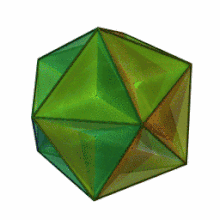Great dodecahedron
| Great dodecahedron | |
|---|---|
 | |
| Type | Kepler–Poinsot polyhedron |
| Faces | 12 |
| Edges | 30 |
| Vertices | 12 |
| Symmetry group | icosahedral symmetry |
| Dual polyhedron | small stellated dodecahedron |
| Properties | regular, non-convex |
| Vertex figure | |
 | |

In geometry, the great dodecahedron is one of four Kepler–Poinsot polyhedra. It is composed of 12 pentagonal faces (six pairs of parallel pentagons), intersecting each other making a pentagrammic path, with five pentagons meeting at each vertex.
Construction
One way to construct a great dodecahedron is by faceting the regular icosahedron. In other words, it is constructed from the regular icosahedron by removing its polygonal faces without changing or creating new vertices.[1] Another way is to form a regular pentagon by each of the five vertices inside of a regular icosahedron, and twelve regular pentagons intersecting each other, making a pentagram as its vertex figure.[2][3]
The great dodecahedron may also be interpreted as the second stellation of dodecahedron. The construction started from a regular dodecahedron by attaching 12 pentagonal pyramids onto each of its faces, known as the first stellation. The second stellation appears when 30 wedges are attached to it.[4]
Formulas
Given a great dodecahedron with edge length E,
Appearance
Historically, the great dodecahedron is one of two solids discovered by Louis Poinsot in 1810, with some people named it after him, Poinsot solid. As for the background, Poinsot rediscovered two other solids that were already discovered by Johannes Kepler—the small stellated dodecahedron and the great stellated dodecahedron.[3] However, the great dodecahedron appeared in the 1568 Perspectiva Corporum Regularium by Wenzel Jamnitzer, although its drawing is somewhat similar.[5]
The great dodecahedron appeared in popular culture and toys. An example is Alexander's Star puzzle, a Rubik's Cube that is based on a great dodecahedron.[6]
Related polyhedra
The compound of small stellated dodecahedron and great dodecahedron is a polyhedron compound where the great dodecahedron is internal to its dual, the small stellated dodecahedron. This can be seen as one of the two three-dimensional equivalents of the compound of two pentagrams ({10/4} "decagram"); this series continues into the fourth dimension as compounds of star 4-polytopes.
A truncation process applied to the great dodecahedron produces a series of nonconvex uniform polyhedra. Truncating edges down to points produces the dodecadodecahedron as a rectified great dodecahedron. The process completes as a birectification, reducing the original faces down to points, and producing the small stellated dodecahedron.
It shares the same edge arrangement as the convex regular icosahedron; the compound with both is the small complex icosidodecahedron.
References
- ^ Inchbald, Guy (2006). "Facetting Diagrams". The Mathematical Gazette. 90 (518): 253–261. doi:10.1017/S0025557200179653. JSTOR 40378613.
- ^ Pugh, Anthony (1976). Polyhedra: A Visual Approach. University of California Press. p. 85. ISBN 978-0-520-03056-5.
- ^ a b Barnes, John (2012). Gems of Geometry (2nd ed.). Springer. p. 46. doi:10.1007/978-3-642-30964-9. ISBN 978-3-642-30964-9.
- ^ Cromwell, Peter (1997). Polyhedra. Cambridge University Press. p. 265. ISBN 978-0-521-66405-9.
- ^ Scriba, Christoph; Schreiber, Peter (2015). 5000 Years of Geometry: Mathematics in History and Culture. Springer. p. 305. doi:10.1007/978-3-0348-0898-9. ISBN 978-3-0348-0898-9.
- ^ "Alexander's star". Games. No. 32. October 1982. p. 56.










